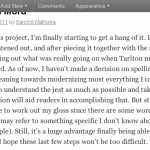The final project for my ENGL1102 course “London City Comedy” is a collaborative digital edition of Tarlton’s Jests, a 17th-century collection of anecdotes about the Elizabethan clown Richard Tarlton. The assignment consists of five parts:
- A draft transcription of one of the individual jests from the original 1613 edition
- A revised transcription incorporating editorial changes and gloss of terms using the OED
- An introductory “Notes about the text” essay that identifies the audience for the edition as each student sees it, and explains why the student has made editorial choices about spelling, grammar, punctuation, and gloss of terms.
- A contextual essay that examines the jest in light of the research work we’ve been doing about Tarlton and early modern comedic drama throughout the semester, as well as identifying patterns that emerge in comparing the student’s jest in relation to the other 74 jests produced by coursemates.
- A weekly blog that documents each student’s progress; students also must comment on one another’s posts to reinforce the spirit of collaborative research and editorial work.
When I first assigned the jests, I looked into the blanching faces of students trying to make sense of admittedly challenging early modern black-letter printing – made more difficult by the bad microfiche PDF’s I was forced to offer them. To give you an idea of what they were working with, here is one of the jests. Tell me how quickly you can decipher it:
As part of the assignment, students have met with me several times in the DevLab, where we can work in teams and use the large monitors to try and reveal elusive letters and words. I encouraged students to try and maintain original spelling in the draft transcription, explaining that it would actually be easier for them to make sense of the jests in the revised version if they could at first resist the temptation to place an “f” in place of the actual long-s “ƒ” and other confusions. In the beginning there was much confusion, and the first two weeks of blog posts expressed frustration sometimes bordering on despair. But as I read this Friday’s blog posts and comments a curious and exciting pattern has emerged.
Not only are students getting the hang of the transcription, many are expressing enthusiasm for the revelations they have made using the OED (thanks to Sherri Brown for making sure we could get access to it!). They’re also starting to compare notes about their parts of the editions, and discovering those patterns I told them they’d find, and to make plans for how they can demonstrate the context of their jests through images and maps (many of the jests make reference to places in London and throughout England). AND many of them are starting to discover the humor in the jests. Granted, some of the jokes come across as creaky and odd, but the more we dig, the more little eureka moments these students are having.
When we first began this assignment, I assured them that there are aspects of comedy that are universal and timeless. I think they’re starting to believe me.


